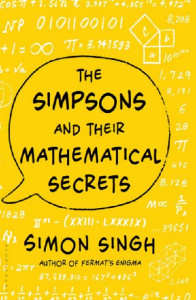The Simpsons and their Mathematical Secrets
 By Simon Singh
By Simon SinghI first learned of this book by watching maths videos of the writer Simon Singh on YouTube. I quickly became fascinated by his enthusiasm for maths and went out and bought his book. The Simpsons is an absolute cultural juggernaut. It has been the longest running sitcom for years now and it’s a struggle to find anyone who doesn’t know something about it. Yet, it is even more of a struggle to find someone who knows that for years now, the writers of The Simpsons have been smuggling maths jokes into their show. In this book Simon Singh uncovers the jokes.
Singh reveals that many of The Simpsons’ writers are very highly skilled mathematicians having Master’s degrees in maths, physics or computer science and sometimes even PhDs. As an example, David X Cohen, one of the writers, graduated from Harvard University with B.A. in Physics, then went to University of California, Berkeley, to get an M.S. in Computer Science.
Throughout the book Singh uncovers and explains maths jokes that most audience members would’ve just glossed over without ever thinking twice about it. He outlines the history behind the maths and explains the mathematical concepts in a way that is understandable to non-experts while also providing further insight for those with some familiarity with the topic. He does all of this with a fun and engaging writing style. One of these maths references is to Fermat’s Last Theorem. There are in fact two references to this in The Simpsons whereby a supposed counterexample is given to this problem. Fermat’s Last Theorem was proven by Oxford’s Professor Andrew Wiles whose name has been given to the Mathematical Institute’s new building, which was opened in 2013.
In addition to looking at mathematics references in The Simpsons, Singh also explores the mathematics references hidden in the show’s sister program Futurama, whose writing staff are also mathematically gifted. For example, Ken Keeler earned an undergraduate degree in maths from Harvard University, a Master’s degree at Stanford University and a PhD in Applied Maths at Harvard University. One of the many mathematical references he introduced into Futurama was the number 1729, which is a reference to the famous conversation between Srinivasa Ramanujan and G H Hardy, two highly regarded mathematicians.
I would highly recommend this book to anyone with even a passing interest in either The Simpsons or mathematics as it is written in an approachable yet interesting style and can be engaged with by a reader of any level.
The Simpsons and their Mathematical Secrets by Simon Singh
ISBN-10: 1408842815
ISBN-13: 978-1408842812
Try checking the availability of this book at your school or local library or explore second hand bookshops and websites. You may also wish to purchase from either Amazon or Blackwell’s.
